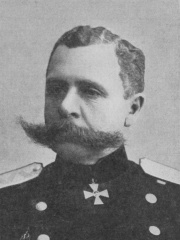
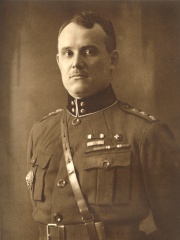

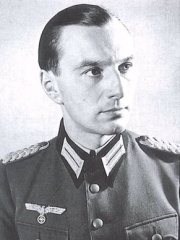
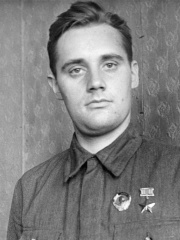
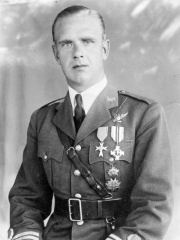
The Most Famous
MILITARY PERSONNELS from Estonia
This page contains a list of the greatest Estonian Military Personnels. The pantheon dataset contains 2,058 Military Personnels, 7 of which were born in Estonia. This makes Estonia the birth place of the 38th most number of Military Personnels behind Syria, and Netherlands.
Top 7
The following people are considered by Pantheon to be the most legendary Estonian Military Personnels of all time. This list of famous Estonian Military Personnels is sorted by HPI (Historical Popularity Index), a metric that aggregates information on a biography's online popularity.

1. Paul von Rennenkampf (1854 - 1918)
With an HPI of 68.87, Paul von Rennenkampf is the most famous Estonian Military Personnel. His biography has been translated into 33 different languages on wikipedia.
Paul Georg Edler von Rennenkampf (Russian: Па́вел Ка́рлович Ренненка́мпф, romanized: Pavel Karlovich Rennenkampf, IPA: [ˈpavʲɪl ˈkarləvʲɪtɕ ˌrʲenʲːɪnˈkampf]; 29 April [O.S. 17 April] 1854 – 1 April 1918) was a Baltic German nobleman, statesman and general of the Imperial Russian Army who commanded the 1st Army in the invasion of East Prussia during the initial stage of the Eastern front of World War I. He also served as the last commander of the Vilna Military District. Rennenkampf gained a reputation as an effective cavalry commander during the Boxer Rebellion and the Russo-Japanese War. Following service in the latter, he led the detachment that suppressed the Chita Republic during the 1905 Russian Revolution. This earned him further promotion, and by the outbreak of World War I Rennenkampf was commander of the Vilna Military District, whose forces were used to form the 1st Army under his command. He led the 1st Army in the invasion of East Prussia and won an early victory at Gumbinnen in late August 1914, but was relieved of command after defeats at Tannenberg, the Masurian Lakes and Łódź, although he was later proved innocent for the mistakes made in the Battle at Łódź by an official inquiry into his actions. Rennenkampf was shot by the Bolsheviks in Taganrog during the Red Terror in 1918.

2. Johan Laidoner (1884 - 1953)
With an HPI of 65.99, Johan Laidoner is the 2nd most famous Estonian Military Personnel. His biography has been translated into 28 different languages.
Johan Laidoner (12 February [O.S. 31 January] 1884 – 13 March 1953) was an Estonian general and statesman. He served as Commander‑in‑Chief of the Estonian Armed Forces during the 1918–1920 Estonian War of Independence and was among the most influential people in the Estonian politics between the world wars. Born in Viiratsi, Kreis Fellin, Governorate of Livonia, Laidoner joined the Imperial Russian Army in 1901 and fought in World War I. Following the Russian Revolution in 1917, he commanded the Estonian national units of the Russian army. In 1918, the Estonian Provisional Government appointed him commander-in-chief of the armed forces of the newly independent Republic of Estonia. After the Estonian War of Independence, he served as a member of the parliament (Riigikogu) from 1920 to 1929. He was once again appointed commander-in-chief during the 1924 Communist coup attempt, and then again from 1934 to 1940. After the Soviet occupation in 1940, he was arrested and deported to Russia, where he died in prison in 1953.

3. Otto von Kotzebue (1787 - 1846)
With an HPI of 65.71, Otto von Kotzebue is the 3rd most famous Estonian Military Personnel. His biography has been translated into 29 different languages.
Otto von Kotzebue (Russian: О́тто Евста́фьевич Коцебу́; 30 December 1787 – 15 February 1846) was a Baltic German naval officer in the Imperial Russian Navy. He commanded two naval expeditions into the Pacific for the purposes of exploration and scientific investigation. The first expedition explored Oceania and the western coast of North America and passed through the Bering Strait in search of a passage across the Arctic Ocean. His second voyage was intended as a military resupply mission to Kamchatka but again included significant explorations of the west coast of North America and Oceania.

4. Bernd Freytag von Loringhoven (1914 - 2007)
With an HPI of 61.47, Bernd Freytag von Loringhoven is the 4th most famous Estonian Military Personnel. His biography has been translated into 24 different languages.
Alexander Otto Hermann Wolfgang Bernd(t) Freiherr Freytag von Loringhoven (6 February 1914 – 27 February 2007), was a Baltic German officer in the German Army during World War II. In 1956, he joined the West German Federal Armed Forces, the Bundeswehr, and rose to the rank of Generalleutnant.
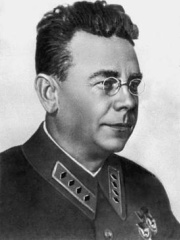
5. August Kork (b. 1887)
With an HPI of 59.36, August Kork is the 5th most famous Estonian Military Personnel. His biography has been translated into 17 different languages.
August Ivanovich Kork (Russian: Август Иванович Корк, also Аугуст Яанович Корк; 2 August [O.S. 22 July] 1887 – 12 June 1937) was an Estonian Red Army commander (Komandarm 2nd rank) who was tried and executed during the Great Purge in 1937. Kork became an officer of the Imperial Russian Army and graduated from the General Staff Academy. He served as a staff officer during World War I and in February 1917 was at the Western Front headquarters. Kork became a Bolshevik and joined the Red Army. He fought in the Russian Civil War, initially as chief of staff of the Bolshevik-sponsored Estonian Red Army and then as assistant commander of the 7th Army. In July 1919 Kork became commander of the 15th Army, defeating Nikolai Yudenich's Northwestern Army and defending Petrograd. He led the army in the Polish–Soviet War and in October 1920 became commander of the 6th Army, which defeated the last White Army in Crimea, led by Pyotr Nikolayevich Wrangel. After the end of the campaign, Kork took command of the Kharkov Military District and later became the assistant commander of the Armed Forces of Ukraine and the Crimea. In October 1922 he took command of the Turkestan Front, fighting against Basmachi rebels. During the late 1920s, Kork commanded the Caucasus Army, several military districts, and was the Soviet military attaché in Germany between 1928 and 1929. Returning from Germany, Kork became commander of the Moscow Military District. In 1935 he became head of the Frunze Military Academy with the rank of Komandarm 2nd rank. At this time he was the highest-ranking Estonian Red Army officer. During the Great Purge, Kork was arrested and shot as part of the Case of Trotskyist Anti-Soviet Military Organization. He was acquitted twenty years later.

6. Arnold Meri (1919 - 2009)
With an HPI of 57.12, Arnold Meri is the 6th most famous Estonian Military Personnel. His biography has been translated into 16 different languages.
Arnold Meri (1 July 1919 – 27 March 2009) was a Soviet World War II veteran and the first Estonian Hero of the Soviet Union. After Estonia became independent, he was later charged with genocide for his role in the deportation of some Estonians to the inhospitable regions of the USSR. He was a first cousin of the President of Estonia, Lennart Meri. At the time of his death, Meri was an honorary chairman of the Estonian Anti-Fascist Committee.

7. Alfons Rebane (1908 - 1976)
With an HPI of 56.76, Alfons Rebane is the 7th most famous Estonian Military Personnel. His biography has been translated into 17 different languages.
Alfons Vilhelm Robert Rebane (24 June 1908 – 8 March 1976) was an Estonian military commander. He was the most highly decorated Estonian military officer during World War II, serving in various Wehrmacht and Waffen-SS units of Nazi Germany. After World War II Rebane joined the British Secret Intelligence Service (MI6) where he played a key role in assisting the armed resistance to Soviet rule in Estonia and other Baltic countries. He led the Estonian portion of MI6's Operation Jungle well into the 1950s. In 1961, Rebane retired from the British intelligence services and moved to Germany, where he stayed until his death in Augsburg in 1976. The 1999 reburial of Rebane in Estonia with state honors triggered a number of controversies.
People
Pantheon has 7 people classified as Estonian military personnels born between 1787 and 1919. Of these 7, none of them are still alive today. The most famous deceased Estonian military personnels include Paul von Rennenkampf, Johan Laidoner, and Otto von Kotzebue.
Deceased Estonian Military Personnels
Go to all RankingsPaul von Rennenkampf
1854 - 1918
HPI: 68.87
Johan Laidoner
1884 - 1953
HPI: 65.99
Otto von Kotzebue
1787 - 1846
HPI: 65.71
Bernd Freytag von Loringhoven
1914 - 2007
HPI: 61.47
August Kork
1887 - Present
HPI: 59.36
Arnold Meri
1919 - 2009
HPI: 57.12
Alfons Rebane
1908 - 1976
HPI: 56.76
Overlapping Lives
Which Military Personnels were alive at the same time? This visualization shows the lifespans of the 6 most globally memorable Military Personnels since 1700.

